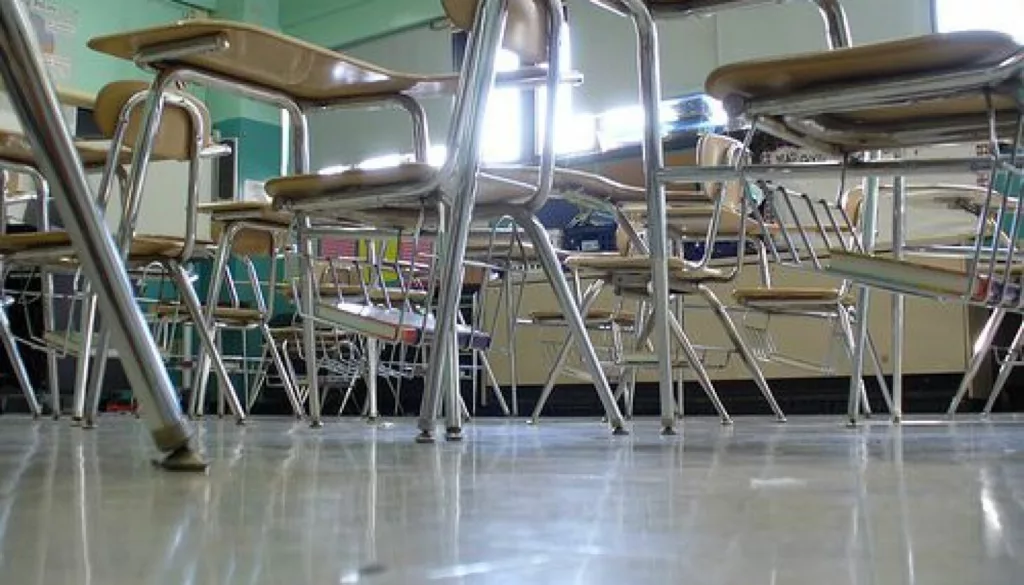[ad_1]
A legislative proposal that could have led to much larger class sizes in Tennessee died Tuesday in its first vote in the Home.
The monthly bill, which conveniently passed out of the entire Senate previously this month, would have eradicated the state’s common course dimension mandates and had appeared to have sufficient support for passage in the House’s K-12 subcommittee.
But Chairman Kirk Haston, a Lobelville Republican who works for Perry County Universities, declared the measure had failed on a close voice vote next spirited debate.
Rep. Kirk Haston chairs the Dwelling K-12 subcommittee.
Larry McCormack for Chalkbeat
The bill’s abrupt ending signifies Tennessee will keep essential classroom common measurements that in essence set the state’s target for districts and constitution educational facilities to observe: 20 pupils for every classroom for kindergarten via 3rd quality, 25 for grades 4-6, and 30 for grades 7-12.
The condition also mandates course sizing maximums at 25 college students in kindergarten via 3rd quality, 30 students in grades 4-6, and 35 college students in grades 7-12.
Sponsors sought additional staffing overall flexibility at area stage
The bill was sponsored by Sen. Jon Lundberg of Bristol and Rep. Debra Moody of Covington, who argued the adjust would give college leaders more overall flexibility when staffing their school rooms. Both equally Republicans chair education and learning committees in their chambers, supplying more fat to their proposal.
Their initial invoice would have ditched most course dimensions requirements. But right after lawmakers received offended comments from a considerable number of constituents about that idea, the sponsors softened the measure to do away with only average course measurement mandates.
Critics argued, even so, that both of those mandates are precious to continue to keep the state’s course measurements in check out.
“Our worry is, after we reduce the normal, that it will be an evitable drift towards bigger course measurements,” mentioned Jim Wrye, representing instructors with the Tennessee Training Affiliation. “We’ve been supporters of preserving the averages as a very good benchmark.”
Tennessee is a person of the couple states with prerequisites in put both for classroom maximums and classroom averages. And some faculty districts currently obtain waivers from the state for individuals mandates.
Lundberg had argued that, though his objective was not to generate more substantial lessons, faculty leaders could use more leeway in certain scenarios, this kind of as when teachers have aides to enable them control their school rooms. And Moody framed the proposal as a “local control” problem.
Many Residence Republicans agreed.
“I have faith in our (districts) and our principals to make the conclusions on how huge a course measurement they set with their lecturers,” stated Rep. Chris Harm, a Republican from Halls. “I have confidence in them that they are not likely to overload instructors.”
But the monthly bill also obtained bipartisan pushback.
Rep. Sam McKenzie, a Knoxville Democrat, predicted that utmost course sizes would promptly grow to be the norm underneath the legislation. And Rep. Bryan Richey, a Republican from Maryville, reported the improve appears counterproductive at a time when Tennessee is working to improve its 3rd-quality literacy level, as effectively as to recruit and retain successful lecturers.
“I like nearby regulate,” Richey stated, “but I believe there are some points exactly where we need to have a ceiling in spot so we’re not heading to have negative actors or terrible decisions becoming manufactured that negatively has an effect on our learners.”
Investigate is mixed on impact of scaled-down classes
Lesser class measurements are extremely well-known with lecturers, who keep they can significantly boost mastering with much less college students in their school rooms. Nonetheless, trying to keep classes modest also means that faculties have to preserve rate by hiring a lot more lecturers and making a lot more lecture rooms.
Does course sizing issue for students’ educational general performance? Investigation is blended.
Chalkbeat’s 2022 investigation of quite a few countrywide experiments confirmed that college students frequently do improved in lesser courses. But there’s no consensus on specifically how a great deal greater, and it is an open up dilemma regardless of whether it is the best use of funding to have much less college students for every classroom.
The most famed and arduous study of course measurement reduction took position in Tennessee beginning in 1985, when some kindergarten learners were randomly assigned to unusually compact lessons by third quality. Take a look at scores in the classes of 13 to 17 students speedily surpassed scores in the greater lessons of 22 to 25. Those people gains persisted for several years, and the students also were a lot more probably to show up at and graduate from college.
Marta Aldrich is a senior correspondent and covers the statehouse for Chalkbeat Tennessee. Contact her at [email protected].
[ad_2]
Resource link
Meet Our Successful Graduates: Learn how our courses have propelled graduates into rewarding
careers. Explore their success stories here!
Discover More About Your Future: Interested in advancing your teaching career? Explore our
IPGCE, MA, and QTS courses today!

Explore Our Courses: Ready to take the next
step in your education journey? View our
comprehensive course offerings now!

